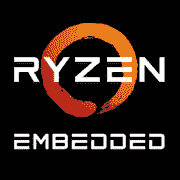AMD Ryzen Embedded R2544

AMD Ryzen Embedded R2544: Detailed Review of the Processor for Embedded Systems and Compact Solutions
March 2025
1. Key Specifications: Architecture and Key Features
Zen+ Architecture and 12nm Process Technology
The AMD Ryzen Embedded R2544, released under the codename Picasso, is based on the Zen+ microarchitecture, optimized for a balance between performance and energy efficiency. The 12nm process, while not the most modern by 2025, ensures stable operation with moderate thermal output (TDP 45W). This makes the chip attractive for embedded systems, industrial computers, and compact PCs.
Cores and Threads: 4 cores and 8 threads thanks to SMT (Simultaneous Multithreading) technology. This configuration is sufficient for tasks requiring parallel data processing, such as managing network equipment or processing media streams.
Cache Memory:
- L3 Cache: 4MB (shared among all cores);
- L2 Cache: 2MB (512KB per core).
Integrated Graphics: Radeon Vega 8 with 8 compute units (512 stream processors) and clock speeds of up to 1200MHz. This allows for operation without a discrete graphics card in basic scenarios, such as outputting to a 4K display or video playback.
Performance:
- Geekbench 6 Single-Core: 1132 (comparable to Intel Core i5-9400);
- Geekbench 6 Multi-Core: 3873 (similar to Ryzen 5 3400G).
Key Features:
- Support for Precision Boost 2 technology for automatic overclocking based on load and temperature;
- Hardware virtualization (AMD-V);
- Enhanced energy-saving capabilities.
2. Compatible Motherboards: Sockets and Chipsets
Socket FP5 and Specialized Solutions
The Ryzen Embedded R2544 uses the FP5 socket, designed for embedded systems and industrial applications. This means that standard consumer motherboards (e.g., for AM4) are not suitable.
Recommended Motherboard Manufacturers:
- ASRock Industrial: IMB-X1212 series with AMD X300 chipset;
- Advantech: AIMB-228 and AIMB-272 models;
- Kontron: Mini-ITX and Micro-ATX boards.
Chipsets:
- AMD X300 (basic feature set, supports PCIe 3.0);
- AMD RX421 (advanced I/O capabilities, including 10 GbE).
Choosing Features:
- Check for DisplayPort/HDMI support for using integrated graphics;
- Pay attention to the number of USB 3.2 Gen 2 and SATA III ports;
- For industrial tasks, support for GPIO (General-Purpose Input/Output) is critical.
3. Supported Memory Types
DDR4 with Dual-Channel Architecture
The Ryzen Embedded R2544 operates with DDR4-2400 MHz memory in dual-channel mode. The maximum supported capacity depends on the motherboard—typically up to 64GB (2x32GB).
Recommendations:
- Use modules with low timings (e.g., CL16) to minimize latencies;
- For surveillance systems or application servers, choose memory with ECC (Error-Correcting Code), if the board supports this feature.
Limitations:
- No support for DDR5—this makes sense given the age of the architecture (the processor appeared in 2019);
- Frequencies above 2400MHz are not officially supported.
4. Power Supply Recommendations
Energy Efficiency and Stability
With a TDP of 45W, the processor does not require a powerful PSU. However, it's important to consider the power consumption of other components:
- Minimum power: 300W (e.g., Be Quiet! Pure Power 11 400W, $60);
- Recommended: 400–500W with an 80+ Bronze certification (Seasonic S12III 450W, $55).
Tips:
- For systems without a discrete graphics card, a compact SFX form factor PSU will suffice;
- In industrial settings, use power supplies with overvoltage protection (e.g., from Mean Well).
5. Advantages and Disadvantages of AMD Ryzen Embedded R2544
Advantages:
- Energy efficiency (ideal for 24/7 operation);
- Powerful integrated graphics for embedded solutions;
- Support for hardware virtualization;
- Long delivery times (up to 10 years for industrial customers).
Disadvantages:
- Outdated 12nm process (compared to 5nm competitors);
- No support for PCIe 4.0/5.0;
- Limited choice of motherboards;
- High price for home users ($250–$300).
6. Use Cases
Where R2544's Potential is Revealed
1. Industrial Computers: Managing machinery, IoT gateways.
Example: A temperature control system on a production line based on R2544 and Linux OS.
2. Media Centers and Digital Signage:
- Support for 4K via HDMI 2.0;
- Low noise level due to passive cooling.
3. Office Tasks: Document processing, video conferencing.
4. Light Gaming:
- CS:GO at medium settings — 60–70 FPS;
- GTA V — 40–50 FPS (720p).
7. Comparison with Competitors
AMD vs Intel in the Embedded Segment
1. Intel Core i3-10100TE (4/8, TDP 35W):
- Weaker in multi-threaded tasks (Geekbench 6 Multi-Core ~3200);
- Integrated graphics UHD 630 lags behind Vega 8.
2. AMD Ryzen 3 4300GE (4/8, TDP 35W):
- Newer Zen 2 architecture (7nm);
- Higher performance in gaming (+15–20%);
- Price: $200–$220 (cheaper than R2544).
Conclusion: The R2544 lags behind newer models in raw performance but wins in long-term support and reliability.
8. Practical Assembly Tips
1. Case: Choose compact solutions (Mini-ITX) with good ventilation.
2. Cooling: An adequate stock cooler or passive heatsink (Noctua NH-L9a) is sufficient.
3. Storage: M.2 NVMe SSD (e.g., Kingston A2000 500GB) for quick OS boot-up.
4. Network: If high speed is required, add a PCIe 2.5 GbE adapter.
9. Final Conclusion: Who Is R2544 For?
This processor is designed for niche tasks:
- Industrial clients needing stability and long lifespan;
- Digital solution integrators (media facades, information kiosks);
- Enthusiasts of compact PCs willing to endure limitations for quiet operation.
Home Alternatives: Ryzen 5 5500GE or Intel Core i5-12400T—offering better performance for the same price.
Prices are current as of March 2025. Please check availability with official AMD Embedded suppliers.
Basic
CPU Specifications
Memory Specifications
GPU Specifications
Benchmarks
Compared to Other CPU
Share in social media
Or Link To Us
<a href="https://cputronic.com/en/cpu/amd-ryzen-embedded-r2544" target="_blank">AMD Ryzen Embedded R2544</a>